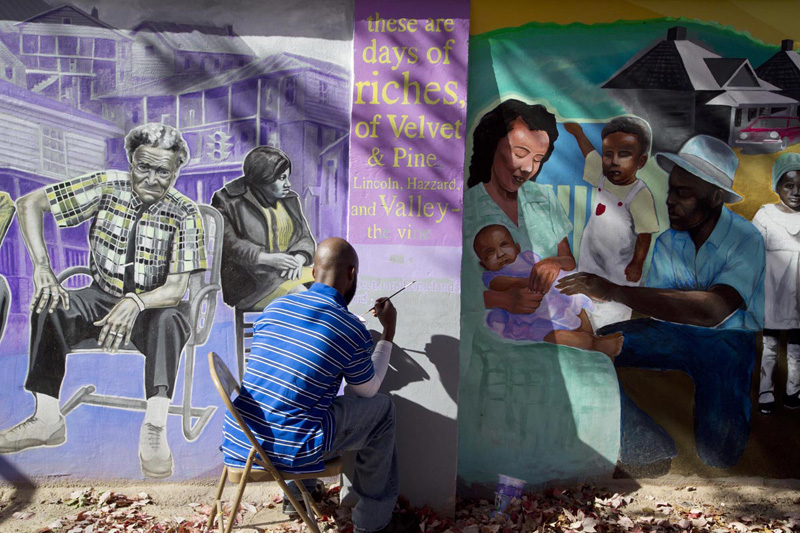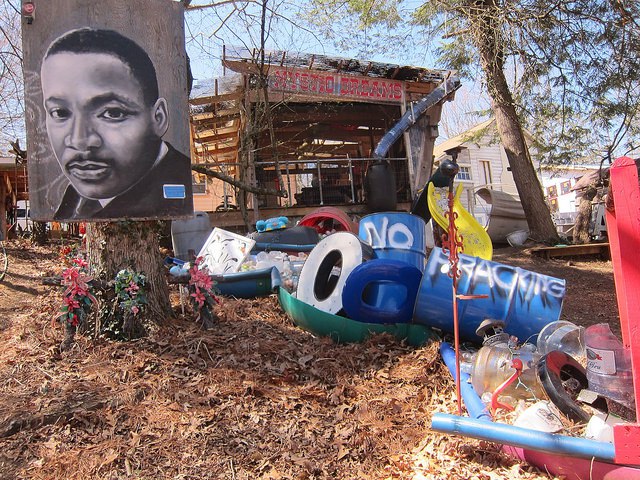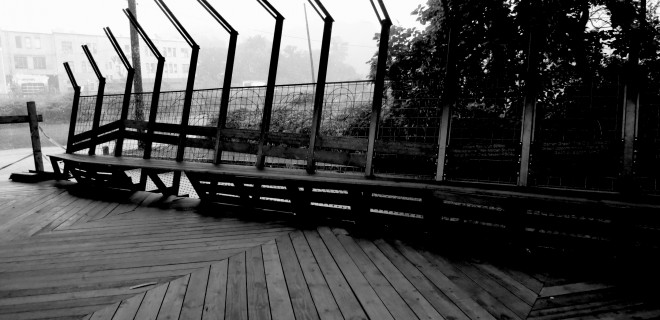Community Planning For All: Trolley Tour Reportback

On January 27, the rain held off just long enough for our Community Planning For All Trolley Tour led by Chris Joyell of the Asheville Design Center (ADC). Nineteen attendees packed onto the trolley to learn about infrastructure projects that were all designed in collaboration between communities in Asheville and the ADC.
West Asheville Bus Shelter

Our tour began at the West Asheville bus shelter across from New Belgium Brewery at the intersection of Haywood Road and Craven Street. For this project, ADC’s volunteer architects held outreach events, listening sessions and design workshops to incorporate the voices of transit riders in the shelter’s design, and even held a public vote online to decide what materials would be used to build the shelter. The result was a “Mix & Match” design using three salvaged materials from the stockyard that once stood at New Belgium Brewery: wood slats, metal, and a bottle cap mosaic. The final design will include an interpretive panel with history about the surrounding neighborhoods.
Burton Street Peace Garden
Formerly a vacant, overgrown lot, the Burton Street Peace Garden was a positive response by the Burton Street community to the war in Iraq and heavy drug activity and crime in their neighborhood in 2003. The site now has vegetable and flower gardens watered by rainwater collection barrels, a fire pit and a cob pizza oven. It also features sculptures and visual art by local artists including Dwayne Barton, telling stories of African-American history and social and environmental justice.
ADC’s 2011 DesignBuild Studio helped design the garden’s 300-square-foot pavilion. Constructed out of salvaged materials from the neighborhood, like an old Texaco gas station sign as the door, the pavilion serves as a gathering and educational neighborhood space.


Photo Credit: Hood Huggers International
13 Bones Pedestrian Bridge

From there we visited the innovative 13 Bones Pedestrian Bridge created by the ADC’s 2013 DesignBuild Studio. Built near the old 12 Bones Barbecue location in the River Arts District, the title is a playful nod to the site’s history. Currently, the bridge is a peaceful place to gather along the French Broad River, and will also be the first piece of infrastructure for the upcoming Wilma Dykeman greenway project along the French Broad.
Triangle Park Mural

Photo Credit: Michael Carlebach
Our tour ended at the Triangle Park Mural, a memorial to the historic African-American business district in the heart of “The Block” in downtown Asheville. The Block was once the cultural and economic hub for Western North Carolina’s African-American community from Reconstruction until the late 1960’s, when close to 500 acres of majority-black neighborhoods were cleared in the East-Riverside Redevelopment Project.
The Triangle Park Mural is a tribute to that history. Its design is the culmination of community interviews, family stories and donated photographs, and celebrates the people of the Block, East End and Valley Street neighborhoods. ADC artist Molly Must painted the mural alongside six local artists and nearly 100 community volunteers, many of whom had their own stories about the Block’s heyday.
MountainTrue believes that creating livable communities in Asheville’s built environments is key to protecting our natural environment too. When we have attractive and functional bus shelters, neighborhood gardens that create food security and strengthen community, places to gather along our region’s waterways and green spaces that celebrate marginalized communities, we come closer to the region we want to live in: one where the health of our natural environment is a priority, and our communities thrive within it. Stay tuned: more community-powered design to come!
